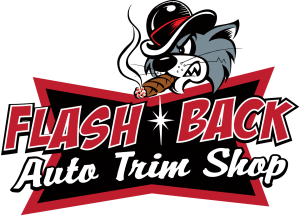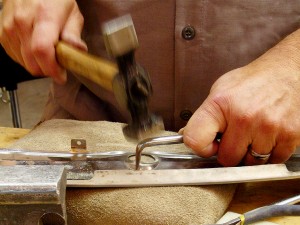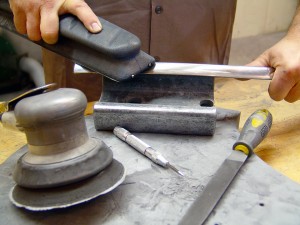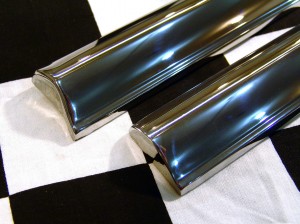Dent Work
At Flash Back we treat each piece as if it were our own. The first thing we do is inspect each part, looking for surface flaws, defects, dents and distortions. These areas are marked on the surface and back side of the piece, and those repairs are addressed first. Folds, creases, and dents can be taken out with hammers, dapping tools, punches and bucks.
Sometimes custom tools need to be made in order to follow a shape or contour and minimize distortion. Back edges and folds are occasionally cut or rolled away in order to gain access to a problem area, and then rolled back. We probably spend the most amount of time at this stage in an attempt to get as much material back into its original shape as possible. That way we’re not removing as much when leveling off the surface, which can cause weakness or require welding. All dents regardless of size are blocked prior to finishing.
Blocking and Profiling
There are others out there who do a fair job of polishing, but need to focus more on profiling. Ever walk up to a restored vehicle, squat down, and look straight down the side of a piece and see waves, wobbles, or ripples? That is poor profiling. At Flash Back all pieces are carefully examined under three different lighting conditions to ensure that they are as straight and true as possible.
If ripples are detectable, they are addressed individually by block sanding with a specialized tool. We take great pride in our block work which will minimize or eliminate these types of distortions. To us it is a visual disruption and is simply unacceptable, a straight “liquid” flow is crucial.
Welding
On occasion, holes and tears need to be filled or built up, or custom pieces may require splicing in order to shorten or lengthen them. In either case welding is required, which is a precise art and science all by itself. It is critical to choose the right alloys in order to achieve an accurate color match. Quick precise welds yield less heat preventing distortion, and careful back purging will ensure that the non-corrosive characteristics of the original stainless are not compromised.
This meticulous type of welding makes for the best repairs possible. The end result?, holes, tears, and joints that are virtually undetectable. Our certified welder is highly skilled at TIG welding and among the best in the business. When not working for Flash Back he is fabricating and welding for the aviation industry.
Finishing
Finishing encompasses the cutting, polishing, and coloring processes. It involves stages of repeated sanding and using compounds on different cutting wheels. After the dent work is completed, the cutting, polishing, and coloring require a six stage procedure.
Polishing is a stage where some shops consider the parts complete, but at Flash Back a piece isn’t complete until it is properly colored. Coloring is a method of ultra-fine polishing that brings out the true color and luster giving a piece its liquid mercury appearance. This is critical when showing indoors making the trim much more brilliant and lustrous. Coloring is also one of the reasons why we are so meticulous about blocking each piece.
If not properly blocked, even a small wave will become accentuated and more obvious under the right lighting conditions. We use the best materials available in our finishing process. No shortcuts or inferior products here, the time saved and finish attained is worth it, leaving each piece with a shine far superior to the factory original.
By flashcat
It is only fair that we discuss some of the differences between chrome plating and stainless polishing. When we set up our vendor booth at automotive events, based on comments, discussion, and questions from the public, there still seems to be plenty of confusion between the two. Chrome […]




